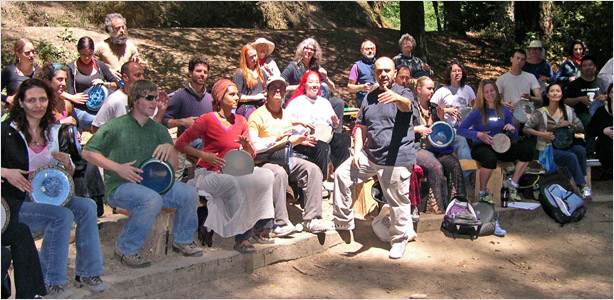|
SCHOOL OF ARABIC PERCUSSION
EGYPTIAN TABLAH & RIQQ
Traditional Classical Techniques
& Rhythms
Beginner Through Professional
Levels

Souhail Kaspar offers private
and group classes for the
Egyptian Tablah (Darabuka or
Doumbek) and the Riqq (Egyptian
Tambourine).
Beginner Level:
In this class the student will
learn instrument position,
flexibility exercises, hand
control techniques for basic dum
and taks, introductory rhythms
and timing. For the Riqq both
classical and cabaret instrument
positions are taught. Emphasis
is placed on staying relaxed
with the use of proper technique
and posture! This class is for
beginners and is also
recommended for higher level
drummers that want to improve
any weakness in their technique
as well as receive guidance to
correct “bad habits”.
Intermediate Level:
In this level there is continued
monitoring of proper hand
control and instrument position.
Hand control techniques for the
half pop, full pop, half tak,
half dum, and rolls are taught.
Numerous rhythms are taught
along with their variations and
embellishments. For the Riqq
different zill techniques and
tones are taught. Classical and
cabaret rhythmic variations are
introduced for both instruments.
Advanced Level:
Musician accompaniment is a big
focus in these classes in
addition to covering the 3
different types of drum solos:
solo to show off the drummer,
solo within a musical
arrangement and solos for the
dancer. Included are techniques
that will spice up your
performance and discussions
regarding working with dancers
and musicians on and off stage.
Appropriate application of
classical and cabaret rhythmic
variations is covered in depth.
Professional Level:
At this level Mr. Kaspar
emphasizes how to “hear” Middle
Eastern music, how it differs
from traditional Western music
and how to create the dynamics
that make it exciting and
soulful. He covers how to
transition from one rhythm to
another, when to use fills and
variations, how to create the
ground for instrumental solos
(takasims) and how to compliment
the melodic line.
DANCE THEORY WORKSHOPS
Understanding to Work Together
EGYPTIAN RHYTHM & MOVEMENT FOR
RAQS AL-SHARQI
Middle Eastern Rhythms and Music
for Dance &
DRUM SOLOS FOR DANCERS &
DRUMMERS
Learning to work together

Souhail Kaspar, the originator
of this unique style for
teaching traditional Arabic
dance theory, began his formal
workshops in the United States
in the 1980’s. In these classes
he serves as a teacher and coach
for all levels of dancers,
drummers and musicians. Mr.
Kaspar gives students the tools
to “hear” Middle Eastern rhythm
and music and the tools to match
the traditional dance movements
of Raqs al-Sharqi to what they
hear. His presentation style is
clear, precise and fun!
“I must be able to see the
rhythm on the dancer’s body…she
must translate the sounds of the
rhythm, instrument and melodic
line on her body in the right
way… If the stage is dark and
there is a spotlight only on the
dancer, she will appear to be
conducting the orchestra with
her body.”
S. Kaspar
Middle Eastern rhythms, music
and dance developed together and
their historical connection is
quite specific. Mr. Kaspar
brings the concepts of this
traditional connection to his
students everywhere. He
de-mystifies the complexities of
Middle Eastern music and gives a
clear format for interpreting
the music with dance.
Both dancers and musicians will
become familiar with the
specific movements used to show
the elements of music—rhythm,
instrumentation and melodic
dynamics—as well as the
movements used to show the tones
and techniques used for drum
solos.
The dance presentation of each
element is described using
explanations and demonstrations
regarding the appropriate body
part to use, the direction that
body part must move in and the
overall style and dramatic
intensity applied to each
movement. The concept of
layering the various movements
to match the intricacies of what
is heard in the music is
explained in detail and
practiced! Students also learn
when and how to incorporate
ethnic folkloric movements into
their classical and modern dance
performances.
With this information the dancer
will be able to perform to live
and/or unfamiliar music with a
sense of comfort and conviction
as she/he will be able to
interpret “in the moment” what
is being played. Mr. Kaspar
teaches easily applied concepts
rather than memorized
choreography! |